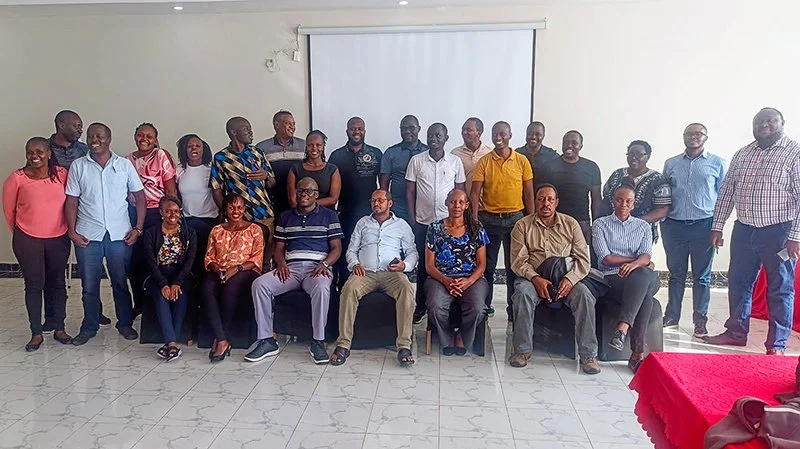AMPATH Partners Guide Integration of Care
AMPATH partners are leveraging decades of experience in both population health and HIV care to lead integration of chronic disease management clinics in Kenya that ensures vulnerable populations with HIV, noncommunicable diseases (NCDs) and other chronic conditions can receive the care they need.
According to the Kenya AIDS Strategic Framework II, HIV contributes to 29% of the country’s mortality and more than 1.5 million people are on lifelong treatment. Caring for people with NCDs also poses a tremendous challenge in Kenya with an estimated 39% of deaths attributable to NCDs according to the Kenya Ministry of Health. Additionally, the overlap between NCDs and HIV is significant in Kenya as 46% of adults living with HIV suffer from two forms of NCDs.
“Integrating HIV services with other healthcare is one of the most important ways to create a sustainable model of care for the future. We planned this from the moment AMPATH started as it was obvious funding would not be forever. It is more relevant now with the change in the funding landscape,” said Professor Sylvester Kimaiyo, chief of party and AMPATH director of care.
AMPATH began enacting integration of HIV and NCD care in 2010 with the development of a memorandum of understanding between AMPATH and the Ministry of Health. Subsequently, the focus on HIV and NCD integration was reinforced in the 2023 PEPFAR Country Operations Plan (COP).
“AMPATH’s care program addresses the comprehensive health needs of our clients, so we are well-positioned to help lead these efforts to accelerate care integration in western Kenya,” Professor Kimaiyo added.
To support integration the current initiative includes the establishment of Centres of Excellence in Integrated HIV and Chronic Disease Clinics at selected pilot locations; technology enhancements for data capture and decision support; clinician training; and development of national guidelines in partnership with the Kenya Ministry of Health and county health offices. “These efforts are in line with recommendations from Kenya’s National AIDS and STIs Control Program (NASCOP) and will help to sustain the impact of the President’s Emergency Plan for AIDS Relief (PEPFAR) investment,” added Kara Wools-Kaloustian, MD, executive director for the AMPATH Consortium in Kenya.
A 3-year grant from the Eli Lilly and Company Foundation (Lilly Foundation) for $3.3 million USD to Indiana University supports its work related to AMPATH. “The Lilly Foundation supports efforts to improve healthcare for people living in resource-limited settings in low- and-middle-income countries such as Kenya,” said Cynthia Cardona, President of the Lilly Foundation. “We are proud to see the progress made by AMPATH, as they lead these efforts and expand access to healthcare in resource-limited settings in Kenya.”
A portion of the grant also supports programs for orphans and vulnerable children.
The Eli Lilly and Company Foundation (Lilly Foundation) was established in 1968 and is supported by donations from Eli Lilly and Company. The Foundation is a tax-exempt, private foundation supporting programs that align with its philanthropic priorities.
Integration includes:
Physical integration—co-locating HIV services within existing healthcare facilities
Service integration—offering HIV services in combination with other healthcare services
Provider integration and training—healthcare workers apply a multidisciplinary approach that provides comprehensive care to their patients
Data integration—Providers have access to complete and accurate data leading to improved decision-making and coordination of care
As part of this work, AMPATH partners joined other leading healthcare organizations in Kenya to review, validate, and consolidate information on HIV service integration from 25 counties at a workshop in Kisumu County. Preliminary findings revealed partial integration in most facilities, with full integration achieved in a few high-volume sites.
The workshop brought together key stakeholders, including representatives from the County Departments of Health, NASCOP, and other implementing partners such as African Medical and Research Foundation (AMREF), Centers for Disease Control (CDC)-Kenya, Kenya Red Cross, Palladium, Christian Health Association of Kenya, and LVCT-Health.
Participants engaged in group sessions to review assessment tools, analyze facility-level data, and identify gaps, strengths, and opportunities in HIV service integration. Key barriers included human resource shortages and weak referral systems. The workshop concluded with the development of a roadmap for report finalization and dissemination, with stakeholders committing to use the findings to inform planning and improve quality of integrated HIV service delivery.
AMPATH also joined other county and implementing partners to review the Draft Integrated Guideline on the Management of HIV, STI, and Viral Hepatitis.
Some of the benefits of integration include improved access to care; enhanced quality of care by providing comprehensive HIV and other health and wellness needs; reduced stigma by eliminating separate HIV clinics; and cost savings by eliminating duplication of services and optimizing the use of existing resources to sustain the successes of PEPFAR.


